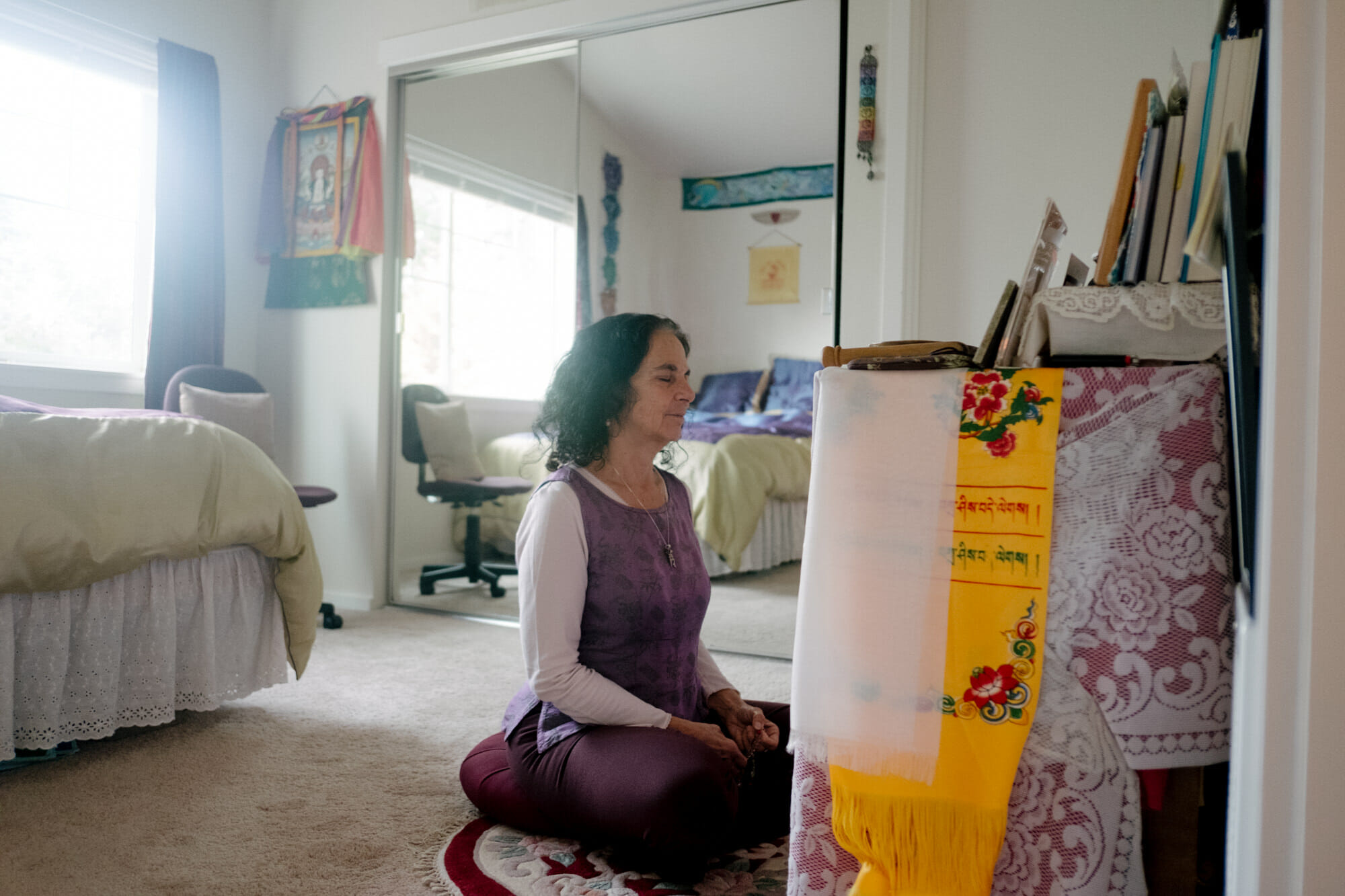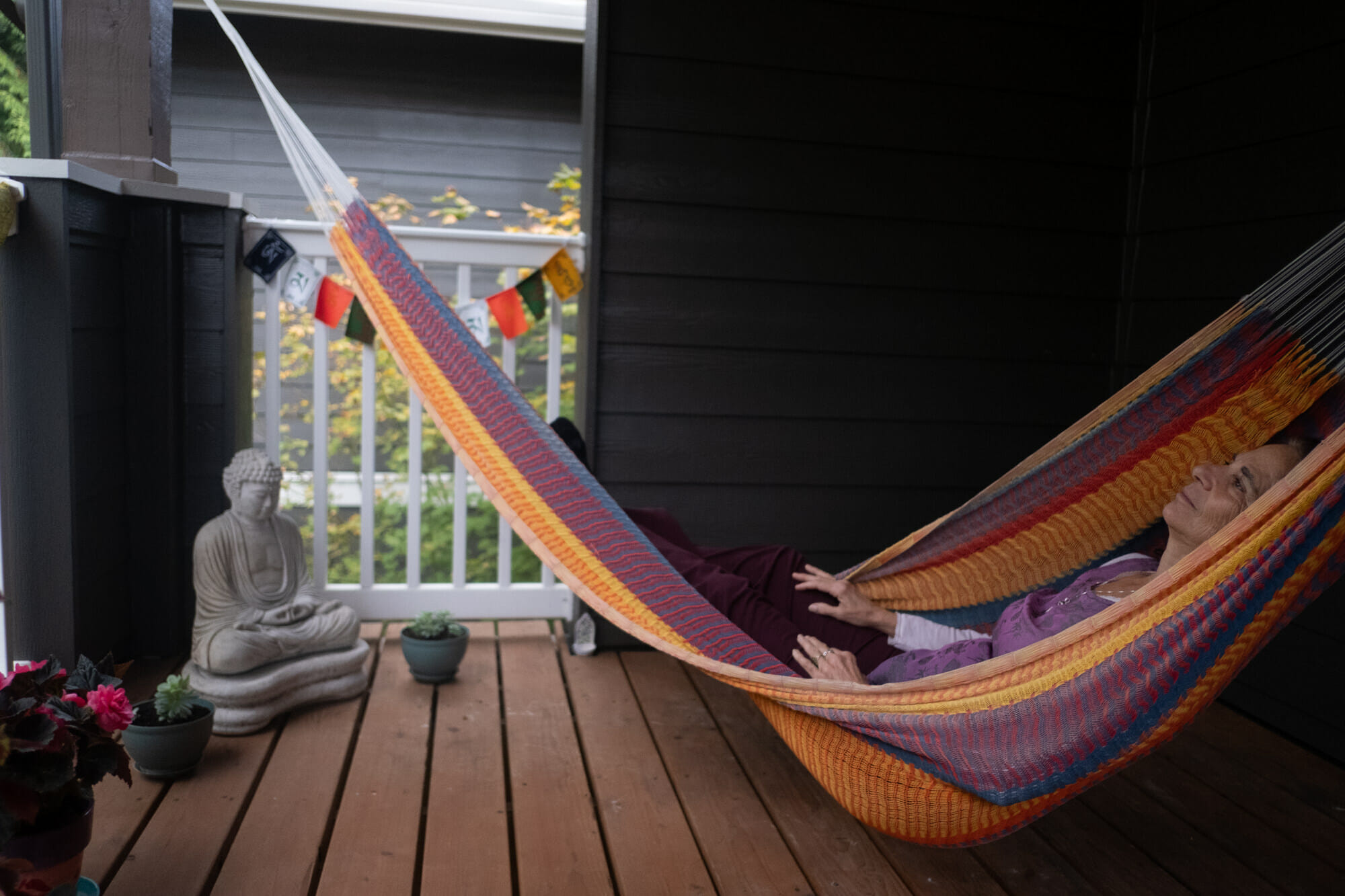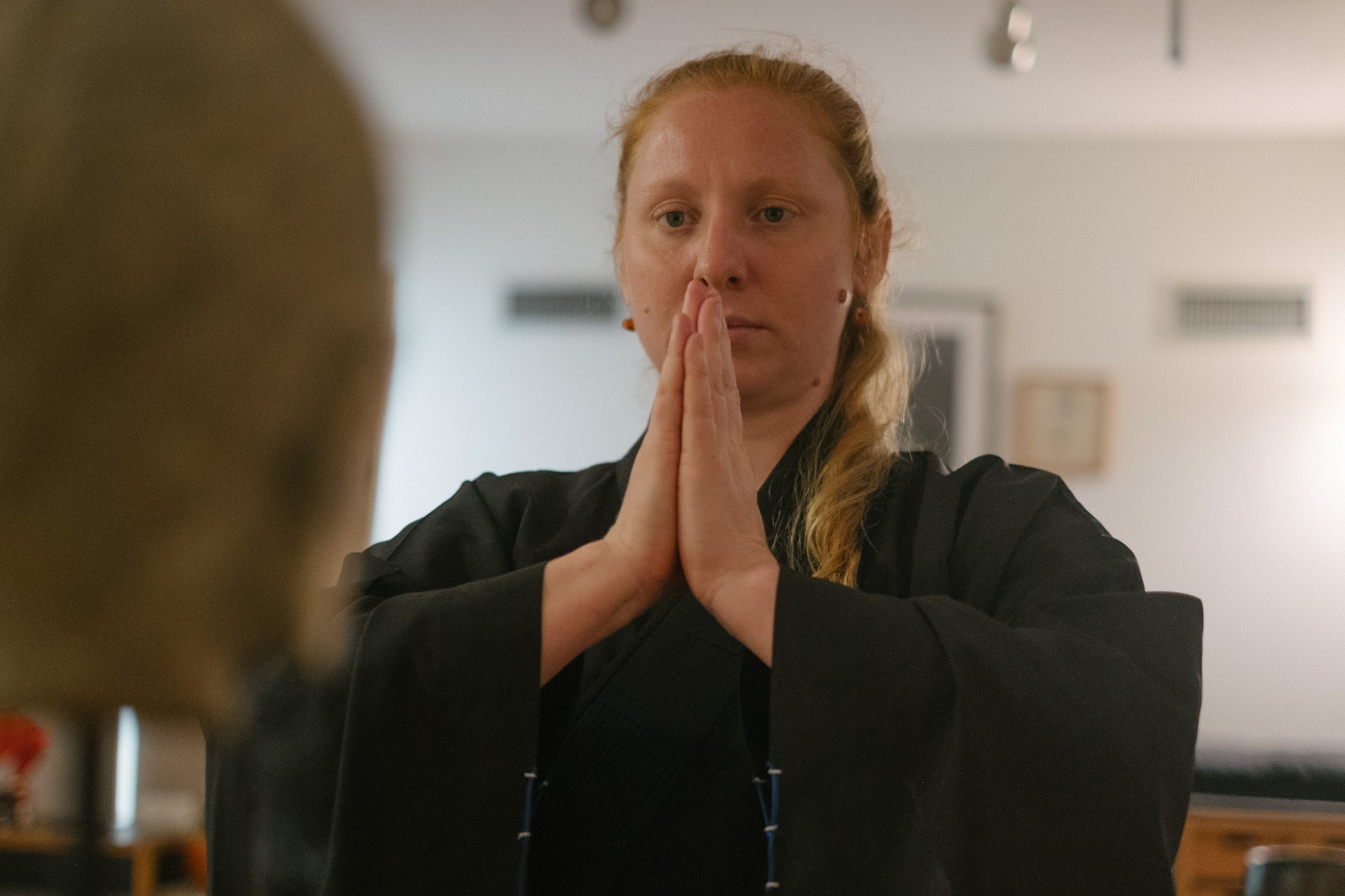When were you first exposed to dharma?
The short simple answer is that I had an experience when I was 5, that I didn’t understand until I began practicing the Buddhist path. I felt that these practices chose me, they landed in my lap.
The details:
I was first introduced to Eastern philosophy when I was about 15. At 16 I read Hesse’s book, “Siddhartha”, and thought, “Ok, I’m the Buddha!” I began to explore yoga at that age, and it was a time of many eastern ways of being introduced into our culture. I came across chanters of various traditions of Buddhism and Hinduism on the streets of NYC where I grew up. I went to CA. when I was 18 and was in a small community that also practiced Zen and held sesshins (which I only explored briefly). Yoga (including Patanjali’s sutras and other Vedic literature) became more of a consistent practice and part of my life when I was 22. I took Refuge with Lama Tenzin probably in 1979 when he first moved to Maui, HI. (where I lived for 21 years). I had no idea what that was about at the time! I did it because the friend that kept asking Kalu Rinpoche to send a teacher to live on Maui, said I should take refuge. It seemed like a cool thing to do, but at the time, even though I’d go to various Tibetan Buddhist teachings (and many high Lamas had been invited to Maui), I thought, ‘this is too complicated, and the meditations are too boring – I’d never be interested in Tibetan Buddhism’.
I was drawn to mystical practices though when introduced to Gurumayi, it filled my devotional heart. I meditated and did yoga and and went to the Siddha Yoga Ashram for many years (maybe ‘82 – 1992). Maui was also a melting pot of many spiritual traditions, and most people I knew were involved in yoga, hinduism, sufism, and buddhism, and whatever earth based rituals were enlivening! The Mandala Dance of the 21 Praises of Tara was first conceived and offered on Maui, and I was there when it was offered to Tai Situ Rinpoche. I was deeply moved by it, but felt too shy to ever dance in something like that. By 1993 I had started to have some interesting kundalini experiences but did not find satisfactory answers to my questions in the Siddha Yoga lineage. One night I had a dream with Gurumayi and she said she couldn’t give me what I wanted, I should go elsewhere. I began praying to find a teacher. I dabbled a bit with Sufism, until….
Before Lama Tharchin Rinpoche came to Maui, a friend said that there was an amazing Lama coming and I could be part of the offering dances to him (through Taradhatu), so I participated. At one of the Red Tara teachings he gave, my heart burst open and I knew he was my teacher. I started doing the Dudjom Tersar ngondro, and also began to dance the Mandala of the 21 Praises of Tara. That’s when I felt that these practices picked me. Vajrayana practice (Nyngma tradition in particular) was just what was in front of me and what I resonated with.
How has the path manifest in your daily experience? Does it reflect in your work and relationships?
To me, it’s all about integration. I’ve become a kinder, less self centered person by doing these practices. I’ve learned to work with and integrate emotions (with the help of Western psychology too). It’s reflected in my work because at a young age I knew I couldn’t fit into the ‘status quo corporate world’, and have been mainly self-employed my whole adult life. I was moved to volunteer and coordinate teachers – was the main coordinator of Vajrayana Foundation on Maui., and then for Anam Thubten (who I had first met through the Vajrayana Foundation) when they came to Maui, and then when I moved to Seattle area. I began volunteering to teach mindfulness to my grandsons’ third grade class last year, and was so appreciated by the students, that now I teach mindfulness to the three fourth grade classes at his school.
If you explore other lineages within buddhism, how did you come to decide on which lineage was right for you?
As mentioned, it seems like the Nyngma lineage is what came to me. I have studied and worked with Gelupas, and Bon, and Kagyu teachers – but my heart practice tends to come back to the Nyngma lineage!
Lama Tharchin Rinpoche still teaches me even though he left his body in 2013. I felt it was him that led me to pick up again with Anam Thubten – who I study and practice with now. As one teacher said to me when I wondered about working with different teachers, “Make your river as wide as it needs to be”. So I feel that there are quite a few streams that feed into my river of ‘awakening’.
What are some of your practices/rituals that you do to support your spiritual development
Yeshe Tsogyal practice, Shamata/Vipassana, Chod, Riwo Sangchod, Mandala Dance (Taradhatu dances), and Focusing (a western practice)
Which sangha do you normally attend ?
Dorje Ling, Samden Ling, Nritya Mandala Mahavihara, Taradhatu, KCC Portland. Being around others on the path of awakening is always a comforting feeling for me.
What is your primarily profession?
I now use the term ‘Health Educator’ as the umbrella term for the facets of my work which are: Yoga Teacher/Therapist, HypnoBirthing Educator, and rep for the BEMER Medical Device. I taught Yoga Therapy for 17 years at a Womens’ Addiction Recovery Center, and needed to not bring religious terms into my work with people. But what I noticed was that after my Tibetan Buddhist retreats (anywhere from 1 – 3 weeks; once or twice a year), I was able to speak with more clarity, in a secular way, to people who are in recovery using the twelve step program. My compassion increased and I even had a hand-out from the yoga world about how we’re all in recovery from samsara (delusions of falsely seeing the world)!
I’ve also done silk painting and when I paint my Rainbow Silk scarves, I chant a prosperity mantra. (and tell some people about that when they buy a scarf)
Being a rep for a Medical Device, I meet lots of sick people, and my practice helps keep me compassionate, and often I will chant (without them knowing, or if I feel they’re open to it, I let them know) the Medicine Buddha mantra for their healing (also do that at the end of yoga class when people are in savasana)
Do you think your personality or background influence the lineage/practices that resonate with you?
Yes! Best example: We were having an opening celebration of a Tibetan Buddhist Vajrayana retreat center on the Big Island of Hawaii (Orgyen Dechen Cho Dzang – Land of Lotus Light). We invited other spiritual groups from the Island to join us in the tsok (a food offering feast). During the ritual we also throw a lot of rice around the room. At the end of the ritual, we all got up to put food on our plates. I filled my plate with all kinds of different foods, piled high, (typical of Feast offerings) and I then noticed the Zen priest sitting there in his simple black robe (us Hawaiian Vajrayana practitioners were wearing colorful sarongs with a maroon shawl draped over it). He was sitting straight and tall and had a few small bites of 3 different foods on his plate, eating slowly.
I then thought, “I’m definitely more Vajrayana than Zen!”. Wild and colorful….as many of the Tibetans I’ve met!
Background
Phyllis traces her introduction to Buddhism back to her teenage years in the early seventies. Initially inspired by Herman Hesse’s books and Eastern philosophy, she delved into yoga and explored various spiritual practices. Despite being more drawn to dance and social activities, her interest in Buddhism grew during her time in California, where she encountered a Zen community. However, it wasn’t until she moved to Maui in the late seventies or early eighties that her connection deepened. Lama Tharchin Rinpoche presence on the island prompted Phyllis to consider taking refuge. Despite finding traditional teachings initially dull, she appreciated the energetic and devotional aspects of Sufi practices.
Her pivotal moment came during a stormy evening at a red Tara event with Lama Tharchin Rinpoche. In the midst of the teachings, Phyllis experienced a profound awakening – the Earth seemed to shake, and her heart opened wide. Without hesitation, she decided to embrace the path of vajrayana and the foundational practices of Buddhism. Despite differences in personal experiences, Phyllis felt a strong, personal connection to Lama Tharchin Rinpoche, highlighting the subjective nature of spiritual journeys.
Lineage
Phyllis, still exploring her spiritual path, felt a deeper pull toward Vajrayana Buddhism after encountering an interview with Chuck Tuku in the Spirit Rock Insight meditation newspaper. Tuku’s analogy of different paths to a destination resonated with her, comparing Vajrayana to taking an airplane for a quicker journey. Although not yet a dedicated practitioner, Phyllis sensed that Vajrayana could facilitate a profound exploration of the personality.
Her interest deepened further through her connection with Lama Tharchin Rinpoche. Phyllis described the experience as akin to falling in love, not with an individual but with a personality embodying richness, wholeness, and completeness. The weight of tradition behind Vajrayana appealed to her, offering a sense of authenticity and depth. Drawing a parallel to the dedication required in mastering a musical instrument, Phyllis appreciated the grounded and visceral quality of her teacher, influenced by a lineage of esteemed mentors.
Refuge
Phyllis reflects on her spiritual journey, drawing an analogy from the Yoga Sutras about evolving on the spiritual path. She likens the initial exploration to choosing a birthday present, evolving into a more focused and intentional search. In her case, the exploration resembles trying on various pairs of shoes until finding the one that fits comfortably.
Her curiosity about life’s purpose dates back to childhood, where she observed family conflicts at the age of five, yearning for a sense of inner freedom. Raised in a time of cultural experimentation, Phyllis embraced a free lifestyle, hitchhiking cross-country at 16 and living in a commune at 18. Despite living creatively and self-employed, she felt an underlying sense of unease and sought a deeper form of freedom.
Introduced to Buddhism in Hawaii at 22, Phyllis found resonance in the concept of inner freedom. Despite already living a free-spirited life, she explored Buddhism to address the deeper layers of internal constraints. Over the years, she followed her intuition and felt a greater presence of guidance, aligning with Buddhist literature’s depiction of the force known as the “esses” guiding all beings.
Phyllis started her journey with yoga not just as physical asanas but inspired by the desire to transcend, influenced by reading “Autobiography of a Yogi.” Initially seeking transcendence, she eventually realized the importance of being grounded on Earth. She describes Vajrayana as akin to root canal work, digging up and addressing deeper emotional challenges. Phyllis emphasizes the importance of compassion, starting with self-compassion and acknowledging and bearing witness to one’s pain and challenges on the path to true understanding.
Other Practices
Phyllis has recently been drawn to and deeply appreciated the chod practice, which literally translates to “cutting through.” This practice involves cutting through the personality, prompting Phyllis to examine her identification with it and gradually loosen its grip. Through chod, she gains insight into what constitutes her personality and finds a path to freedom.
During an extended retreat with Lama Tharchin Rinpoche, Phyllis learned the importance of integrating these practices deeply into one’s being, comparing it to leaving a profound footprint in the heart rather than a detachable patch on pants. She acknowledges the weight of history and the transmission of these practices, utilizing the mind, speech, and body along with instruments like bells and drums to make the practice more tangible and authentic in her life.
Parenting
Phyllis embraced a mindful approach to parenting, recognizing that her presence within herself allowed her to be more present with her son and attuned to his needs. Living in a spiritual community in Hawaii, they collectively created a nurturing preschool environment, integrating spiritual principles such as compassion, loving kindness, and firm boundaries.
The community acted as a support system, embodying the proverbial idea that it takes a village to raise a child. They encouraged open communication and took on shared responsibilities for guiding and correcting the children. Phyllis extended this communal approach to her own parenting, bringing her son to retreats and exposing him to various spiritual practices, including Buddhist and Sufi retreats.
As a teenager, her son expressed skepticism about organized religion due to its association with conflicts. He suggested a religion based on kindness, a sentiment resonant with Phyllis’s own spiritual values. Despite not following a specific path, her son demonstrated the practical application of these teachings. He offered a safe haven for friends who were too intoxicated to drive, showcasing a compassionate and responsible approach to addressing real-life situations. Phyllis took pride in his practical application of teachings, emphasizing the importance of making spiritual principles tangible in everyday life.
Tara Dance
Phyllis recounts her introduction to the Mandala Dance of the 21 Praises of Tara when her son was two years old, performed on a cliff in Kauai, Hawaii. The dance left a profound impact on her, as she witnessed the devotion and felt a deep connection to the essence, or “Moana,” of Hawaii. Initially hesitant to join the dance due to shyness, Phyllis gradually became involved over the years.
The Mandala Dance became an annual practice for the women in the community, with men participating as protectors. Phyllis emphasizes its inclusive nature, attracting individuals irrespective of their familiarity with Buddhism or meditation. The dance is described as a way to embody the great feminine principle symbolized by Tara, fostering purification and devotion.
Phyllis shares stories of individuals transformed by the Mandala Dance, including an autistic woman who found newfound independence and another woman who overcame personal challenges. The dance, rooted in the traditional Tibetan Buddhist sadhana, unfolds in circles and spirals, each praising Tara with unique choreography.
The dance is also a form of Tonglen, a practice of giving and taking, where participants, embodying Tara, symbolically take in the world’s suffering and transform it into wisdom and compassion. Phyllis underlines the importance of protectors in creating a sacred space for the dance and highlights the dance’s power to uplift humanity through joyful, sacred practices.
Teacher
Phyllis reflects on the complex dynamics of the teacher-student relationship, comparing it to the intricacies of falling in love. She likens her experience with Lama Tharchin Rinpoche to a tuning fork that brings her in harmony with her essence. Acknowledging the challenge of discerning the essence amidst the teacher’s personality, she emphasizes the importance of moving beyond surface attributes.
Phyllis highlights the potential pitfalls of fixating on a teacher’s personality, recognizing the need for a discerning mind and a heart of devotion. She shares her personal journey, emphasizing a longing for something greater and a sense of wholeness that drew her to her teacher. Phyllis acknowledges the shift in her practice after her teacher’s passing, feeling a sense of drifting that led her to explore silent meditation with another teacher, Sharma.
Drawing parallels to learning an instrument, Phyllis describes the initial stages of practice as playing scales, where foundational teachings are imparted by the teacher. She emphasizes the evolution from foundational practices to creative exploration, where the focus shifts from the teacher to the essence of the teachings. While acknowledging the importance of the teacher-student relationship, Phyllis also encourages individuals to navigate their unique paths and assimilate teachings into their lives.















































































